*The following is part of a series of blog posts researched and written by Mark Clardy, SRM Docent and independent scholar.*
Symphony of Native America
Movement 3
The Buffalo Hunt
Music has always been a part of Native American life, with songs and ceremonies surrounding everything of importance. In this movement of our ongoing “Symphony of Native America,” we’ll hear the melodies and drumbeats from several Plains tribes that commemorate one of their most important events: the buffalo hunt.
Lyrics in Native American songs are most often vocables (syllables without meaning), or sometimes just a few words with implied references or meanings which were understood in the original social context. When longer English texts are provided for the songs, the intent is not to provide a translation, but to provide some sense of what the song meant to the original listeners.
There are several buffalo hunt paintings in the Sid Richardson Museum’s collection, mostly by Charlie Russell. For this Movement, each painting is associated with music from a different tribe as recorded and transcribed by the early pioneers in research of the music of American Indians: Frances Densmore, Alice Fletcher, Frederick Burton, and Natalie Curtis. Please look carefully at each painting while listening to the music of various tribes.
The Buffalo Hunt & “Three Pawnee Buffalo Hunt Songs”

Photo: Buffalo herd near Pawnee, Oklahoma, about 1920
Frances Densmore attended a Pawnee Buffalo Dance in about 1920, at which Wicita Blain (or Tutukrawitsu, “He overtook the enemy”) sang several songs that Densmore recorded in Pawnee Music, BAE Bulletin 93, 1929.
The first song in this set is “The Herd Passes Through the Village.” A great herd of American bison came to the place where the American Indians were encamped and threatened the destruction of the village. Naru’dapadi, the singer’s uncle, rode toward them, shouting and firing his gun in an attempt to divert them from their course, but he was caught in the herd. There were buffalo on all sides of him as the herd swept through the camp and across a stream, carrying him with them.
Translation of song:
Listen, he said, Now he sits among the buffalo,
These are his sayings, Now he sits among them as they come,
Now they have passed through the village, Now they have crossed the stream,
He flies above them here and there, shouting and calling.
The second song is “The Buffalo Are Coming” which concerns a dream of buffalo by the singer’s grandfather. He was in his lodge when he saw a distant animal approaching, which he thought was a horse. But as it came nearer, the horse became a buffalo, and told him of many good things that would happen to him.
Translation:
Listen, he said, yonder the buffalo are coming,
These are his sayings, yonder the buffalo are coming,
They walk, they stand, they are coming,
Yonder the buffalo are coming.
The third song is “The Waves of Dust.” Long ago an old man had a dream in which he saw a cloud of dust rolling along the ground. He sat and looked at the dust a long time until late in the afternoon. Then it looked like a crowd of people, but after the dust storm had passed he saw a great herd of buffalo.
Translation:
Listen, he said, there the buffalo are coming in a great herd,
These are his sayings, there the buffalo are coming in a great herd,
The waves of dust roll downward, there the buffalo are coming in a great herd,
They mark the place of the buffalo wallow.
Now look closely at The Buffalo Hunt by Charles Russell (1899) while listening to Three Pawnee Buffalo Hunt Songs.
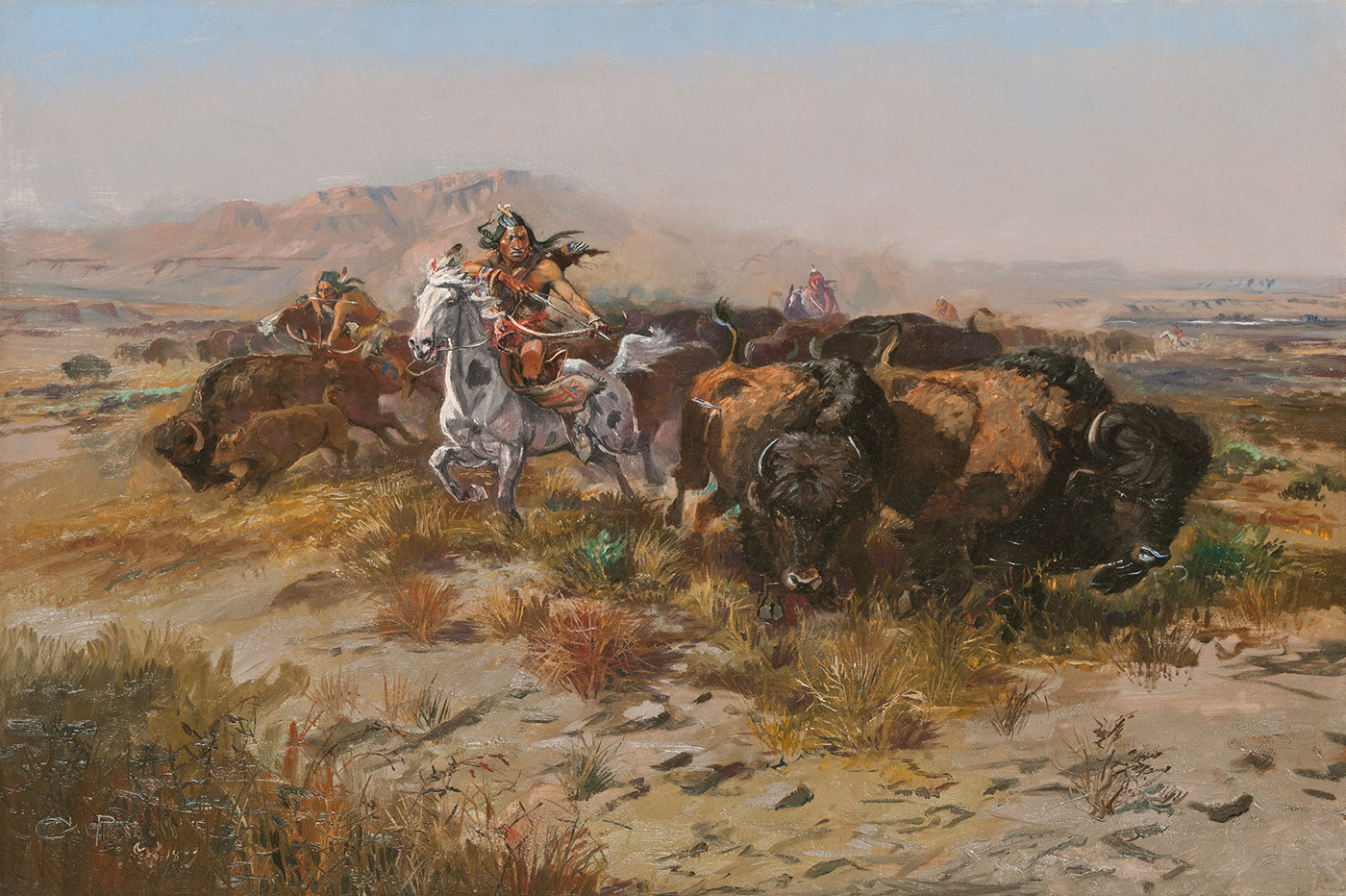
The Buffalo Hunt (Wild Meat for Wild Men) | Charles M. Russell | 1899 | Oil on canvas | 24.125 x 36.125 inches

Photo: Buffalo wallow near Pawnee, Oklahoma, about 1920
Wild Man’s Meat & “Three Ojibway Buffalo Songs”
Frederick Burton transcribed many Ojibway songs and their stories in American Primitive Music (1909), including three buffalo songs (p. 249-250). He wrote:
“The Indian who sang these for me evidently believed that he was making a great concession and contributing something of rare importance. It had taken him a long time to decide that he would do so, and at the last moment he threatened to back out because a young man happened to pass the house. ‘I don’t want any of the young fellows to hear these, or know that I sing them,’ he growled. Assured, at length, that no one was in hearing, he sang, but refused to dictate the words. Other Indians to whom the cylinders have been submitted say that the songs are prayers. They claim to understand the general purport of the songs but are not certain of all the words.”
Burton’s interpreters provided the following translations for the songs.
1: “I hear the tread of the buffalo in the distance; I wait for him in ambush.” The interpreter explains that this is a prayer that the buffalo may not smell the enemy and turn aside.
2: “I have found the tracks; all are going around this way; we will go around, too, and head them off.”
3: “I’ve followed him so far that his tongue is hanging out; he will have to go to the river to drink, and there I will kill him.”
Now look closely at Wild Man’s Meat by Charles Russell (1899) while listening to Three Ojibway Buffalo Songs.
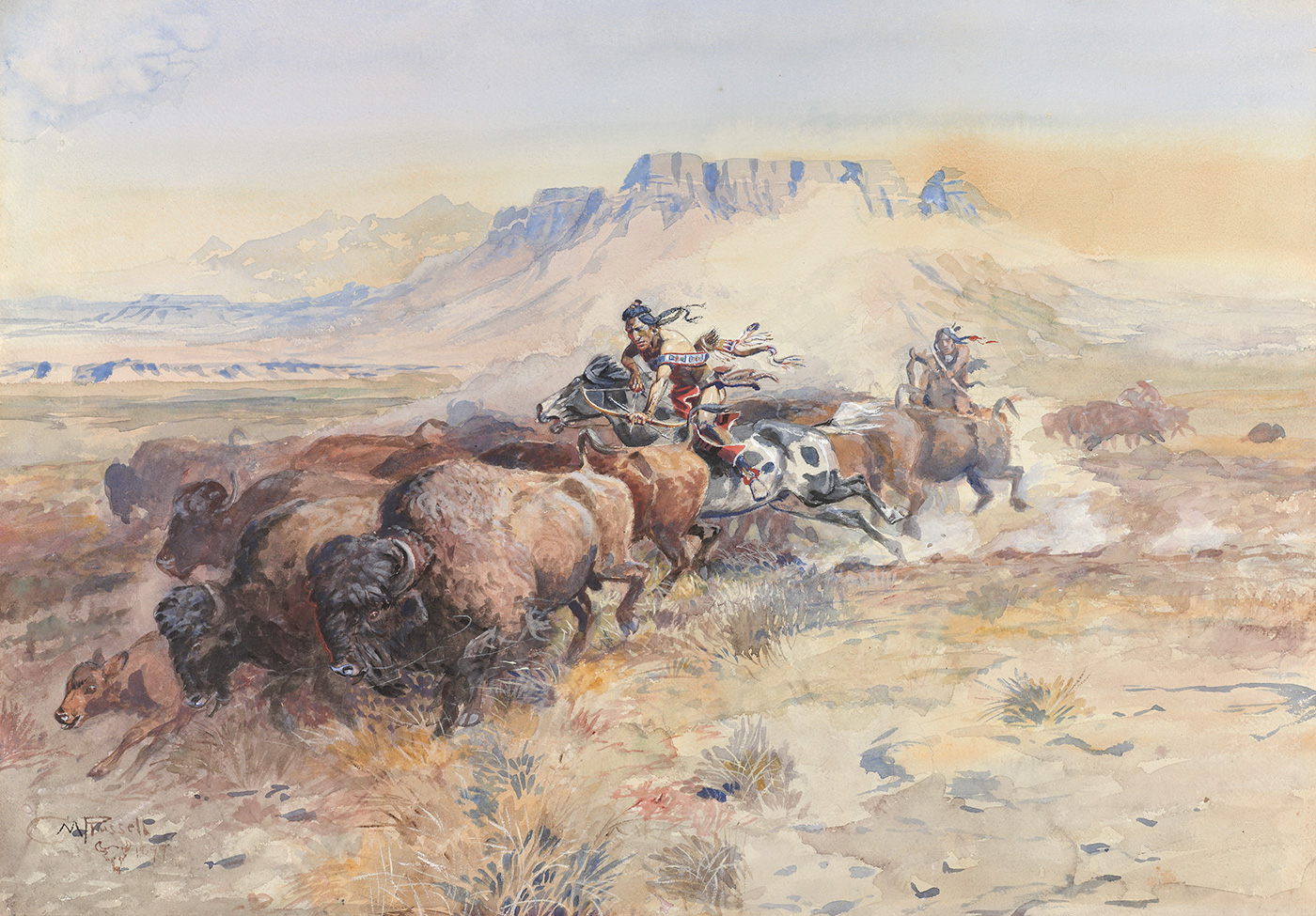
Wild Man’s Meat (Redman’s Meat) | Charles M. Russell | 1899 | Pencil, watercolor and gouache on paper | 21 x 30 inches
The Buffalo Runners & “White Buffalo”, Traditional Métis
We have seen Frederic Remington’s Buffalo Runners – Big Horn Basin in the introduction to this “Soundtrack of the West” series and have heard some traditional Métis music. Now take another look at the painting while listening to “White Buffalo”, a traditional Métis fiddle tune from the Fort Belknap Reservation in Montana (from the Traditional Tune Archive, tunearch.org)
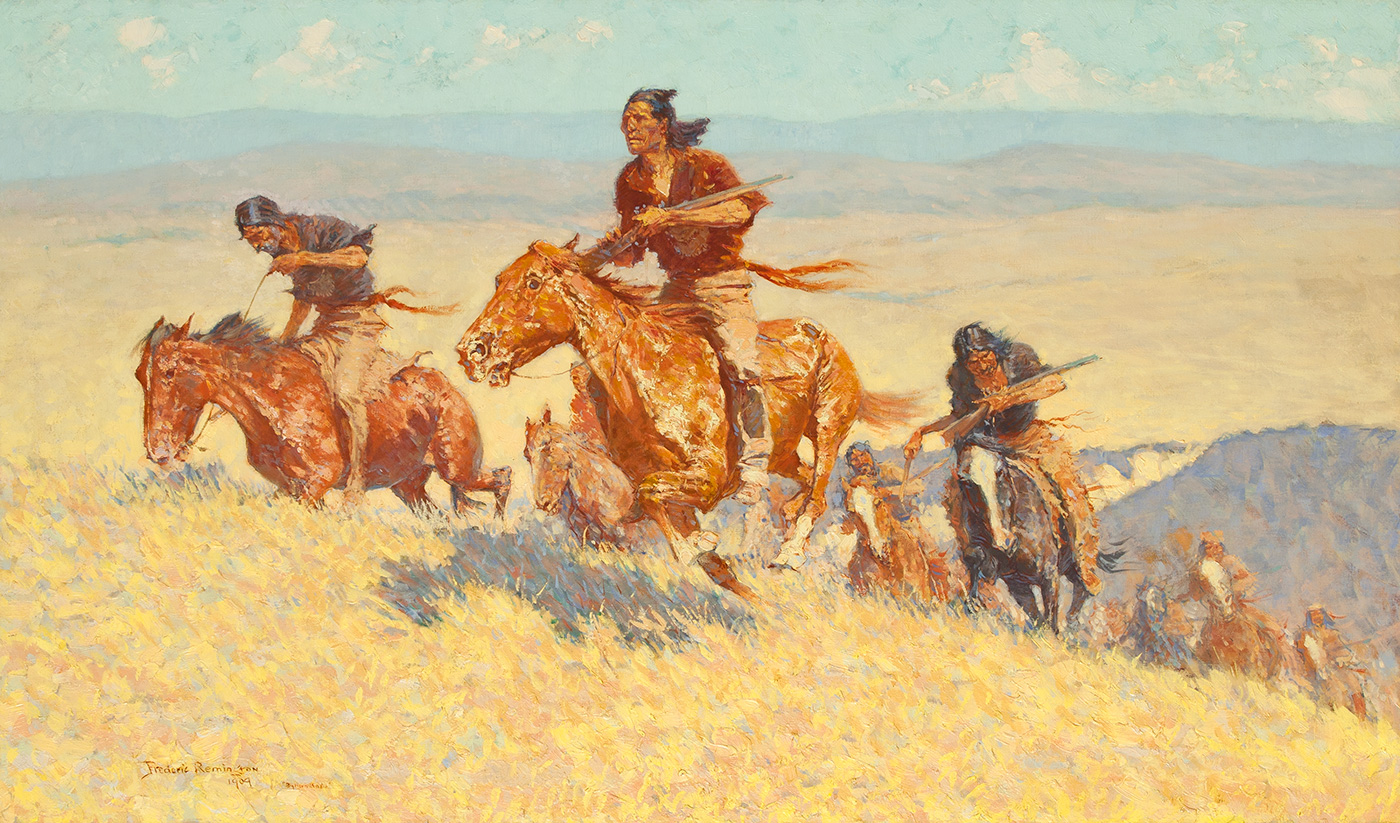
Buffalo Runners—Big Horn Basin | Frederic Remington | 1909 | Oil on canvas | 30.125 x 51.125 inches
Wounded & “Omaha Buffalo Mystery Song”
Charles Russell painted Wounded in 1909, after an up-close-and-personal experience in a buffalo roundup. In A Study of Omaha Indian Music (1893), Alice Fletcher included Song No. 78 which “is sung by the Buffalo doctors when attending a wounded man – during the preparation and application of the remedy to the wound. The medicine is generally sprayed from the lips with considerable force so that it may reach every part of the lacerated flesh. The song indicates that this mode of treatment was inculcated in the vision” (p. 50; song p. 140).
Translation: “From here do I send it [i.e., the medicine to the wound] thus. In this manner am I bidden to send it.”
Feel free to contemplate your preferred method of treating a buffalo horn laceration while looking at Wounded and listening to “Omaha Buffalo Mystery Song”. The unaccompanied song is first, followed by James Comfort Fillmore’s harmonized version in Fletcher’s publication.
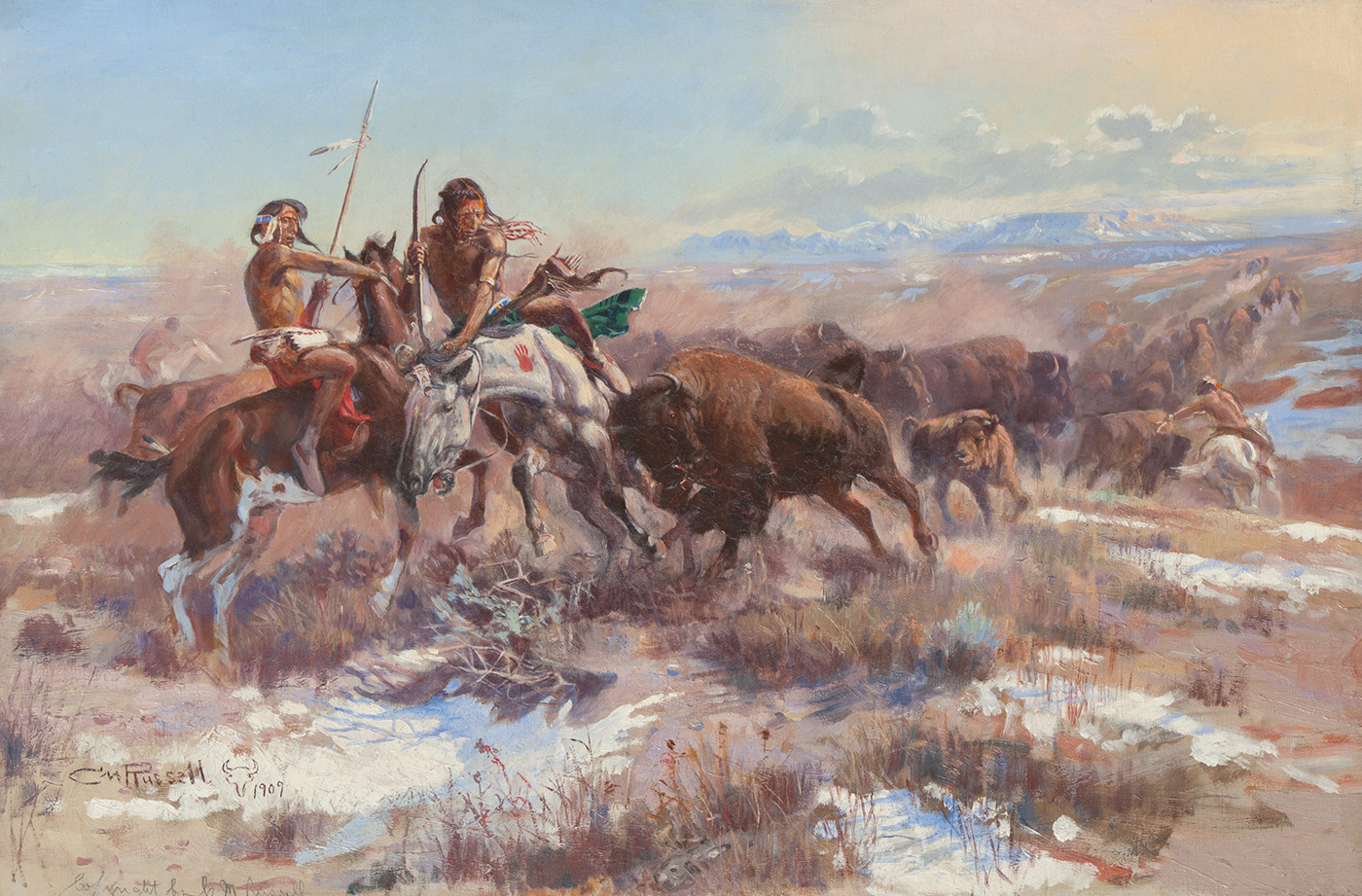
Wounded (The Wounded Buffalo) | Charles M. Russell | 1909 | Oil on canvas | 19.975 x 30.125 inches
Indians Hunting Buffalo & “Four Teton Sioux Buffalo Songs”
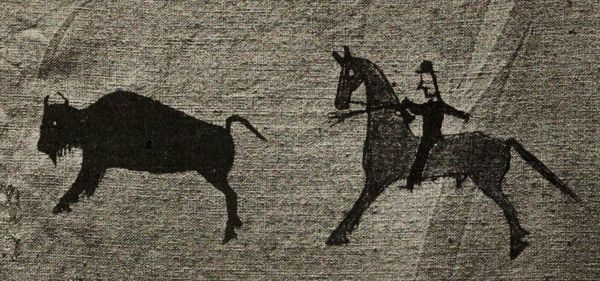
The Last Buffalo Hunt – 1882 Densmore BAE61 1918 p437
Charlie Russell painted Indians Hunting Buffalo in 1894, possibly with instructions to imitate prior paintings of braves on charging steeds ahead of their targets. Frances Densmore provided detailed information about the Teton Sioux buffalo hunt, or “Wana’sapi”, and its associated songs, in Teton Sioux Music, BAE Bulletin 61, 1918 (p. 436-447).
Indian agent Maj. James McLaughlin supervised the last buffalo hunt on the Standing Rock Reservation in 1882, when 600 mounted Sioux killed 5,000 buffalo. That year was recorded in the Sioux picture calendar as “Wable’za Tataŋ’ka-iyo’take wana’ nape’yuza wani’yetu”, or “Winter in which Maj. McLaughlin with the Sioux went on a buffalo hunt.” The drawing from the calendar is shown here (the hunter is clearly behind the buffalo.)
The first song in this set, “Song to Secure Buffalo in Time of Famine”, is a medicine-man’s song sung by Siya’ka who vouched for the song’s effectiveness. He said that in the old days, after a ceremony on the part of the medicine-man and the singing of this song, the buffalo came near the camp and thus famine was relieved.
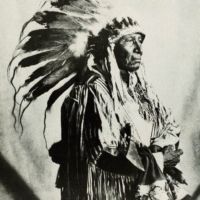
Siya’ka
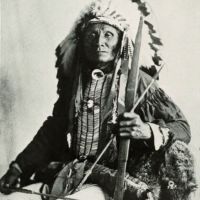
Gray Hawk
The next three songs in the set were sung for different phases of the buffalo hunt. It was an intricate, even ceremonial, event as described in Densmore’s book. Song (a) was sung as the hunters depart to search for the buffalo herd. Song (b) was sung when they returned to report to the tribe on size and location of the herd. Song (c) was a song of the chase, as sung by Gray Hawk.
Now look carefully at Indians Hunting Buffalo and imagine what that last buffalo hunt was like in 1882, while listening to Teton Sioux Buffalo Hunt Songs.
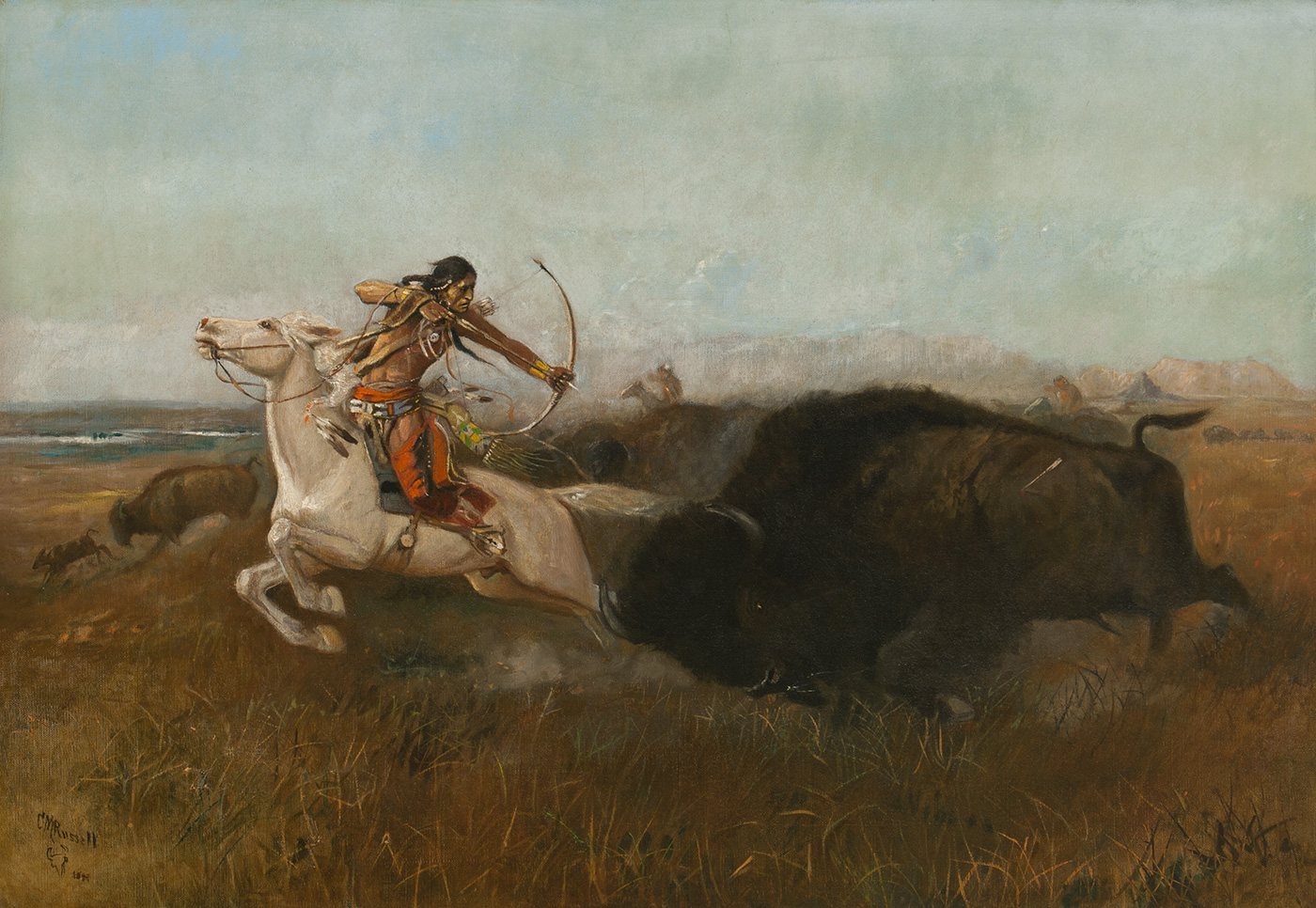
Indians Hunting Buffalo (Wild Men’s Meat; Buffalo Hunt) | Charles M. Russell | 1894 | Oil on canvas | 24.125 x 36.125 inches
Guardian of the Herd & Mandan Buffalo Songs
Charlie Russell painted this watercolor depiction of a buffalo herd in 1899, featuring one large buffalo as the “Guardian.” The songs accompanying this painting are from Frances Densmore’s 1923 book Mandan and Hidatsa Music, BAE Bulletin 80. The first one, “Song of the Buffalo” (Song No. 19, p. 70), was at the end of a long story after an old buffalo character said: “Sing my song and whatever you desire will come to you. If you desire the wind, it will come to you, or the buffalo will come, or the eagles will come when you sing this song… This is the buffalo’s song.” (Translation of Mandan lyrics: “We arrived at the lodge; they arrived at the lodge.”)
The second song, “Song of the Leader of the Buffalo Herd” (Song No. 31, p. 86), fits nicely with Russell’s painting, and is from the origin of the Mandan Buffalo Dance Society. Densmore provided the following translation and comment:
“The leader of the herd says, ‘We will walk in that mud.’” The buffalo always avoid mud holes when they are traveling, but in this song the leader of the herd assures them that he will take them safely through.
Now, listen to “Mandan Songs of the Buffalo” while looking into the eyes of the Guardian of the herd.
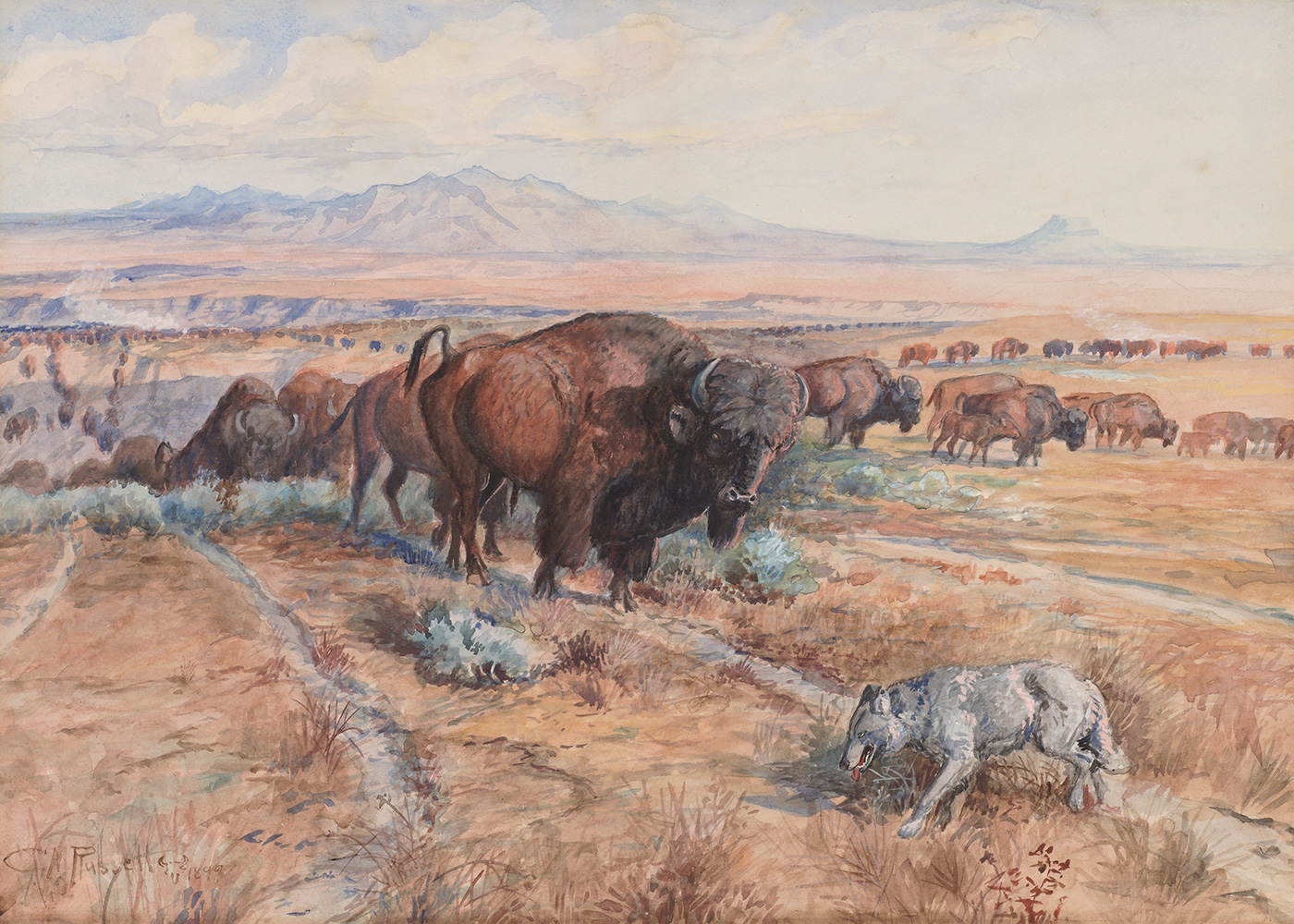
Guardian of the Herd (Nature’s Cattle; Buffalo Herd; Before the White Man Came) | Charles M. Russell | 1899 | Watercolor, pencil & gouache on paper | 20.625 x 29.125 inches
Buffalo Hunt & Cheyenne “Mahoeva No-otz”
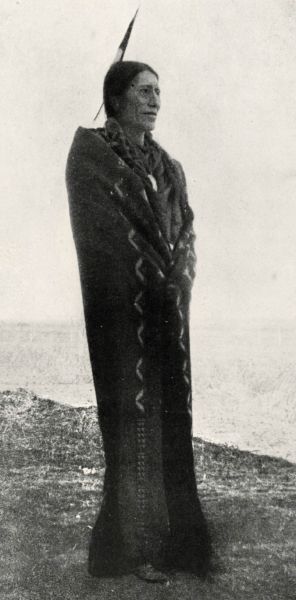
Chief Hiamovi, “The Indians Book,” p150
Our last buffalo painting, Russell’s Buffalo Hunt (1901) is paired with “Mahoeva No-otz”, a Cheyenne Buffalo Dance song from The Indian’s Book, by Natalie Curtis, 1907 (p. 152, 168). The song belonged to both the Red Shields Society and the Chiefs’ Society. It was sung by Cheyenne High Chief Wihu-hwaihu-o-usz (or “Hiamovi”) who described it as “an old song of high importance.”
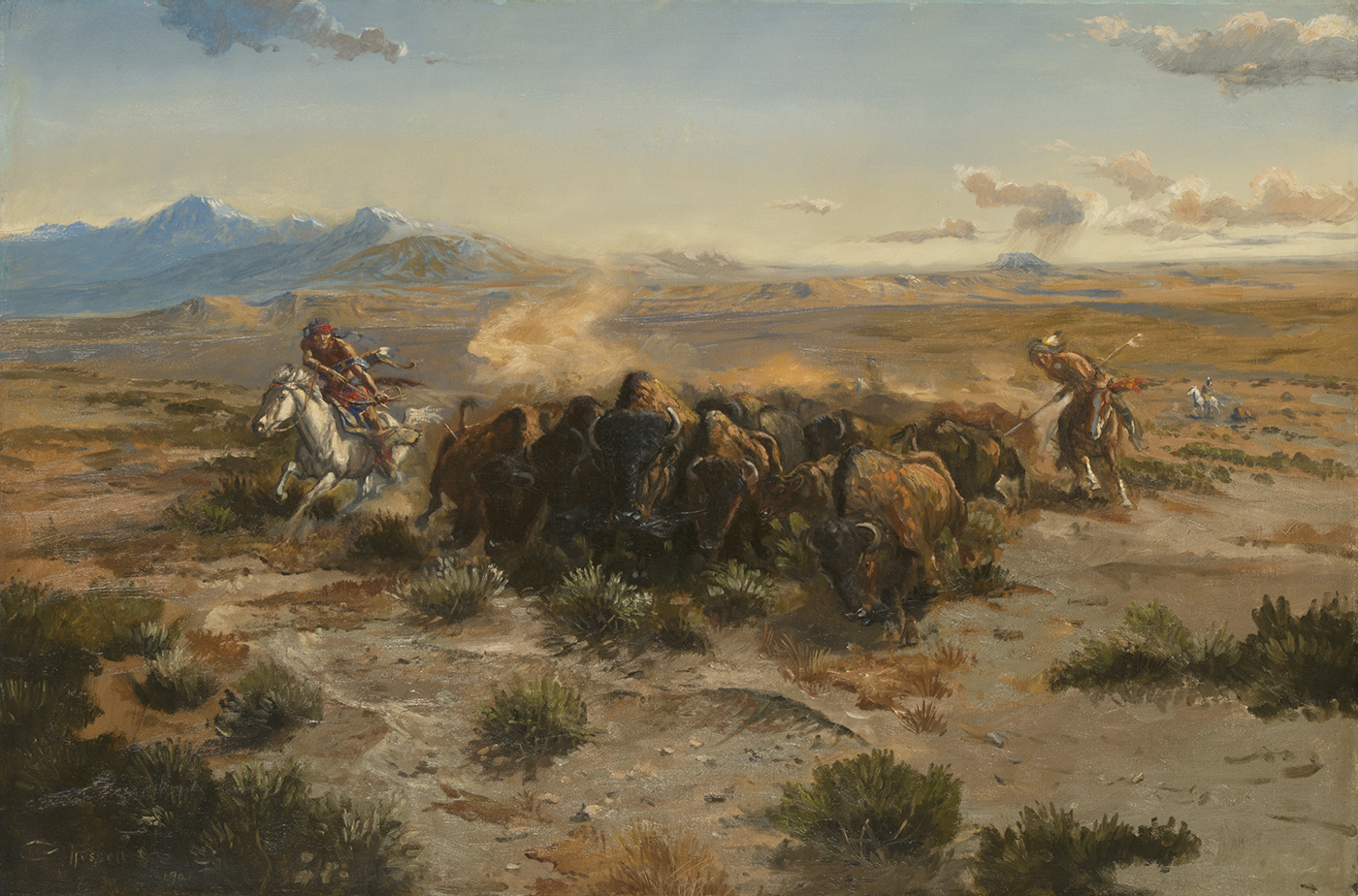
Buffalo Hunt | Charles M. Russell | 1901 | Oil on canvas | 24.125 x 36.125 inches
This concludes the Native American songs in this Third Movement of our Symphony of Native America, but there remains one last section, a “coda” – just for fun.
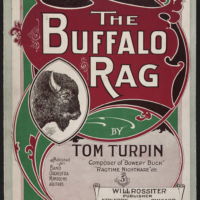
Turpin, T. (1904) TheBuffalo Rag. Will Rossiter, monographic. [Notated Music] Retrieved from the Library of Congress, https://www.loc.gov/item/ihas.200033228/.
CODA
There is a ragtime piano piece by an African American composer of the early 1900s, completely unrelated to Native American music but referencing the American bison.
“The Buffalo Rag”, by Tom Turpin, 1904.
In the final Movement in the Symphony of Native America, we will cover the paintings and songs of the Southwest.



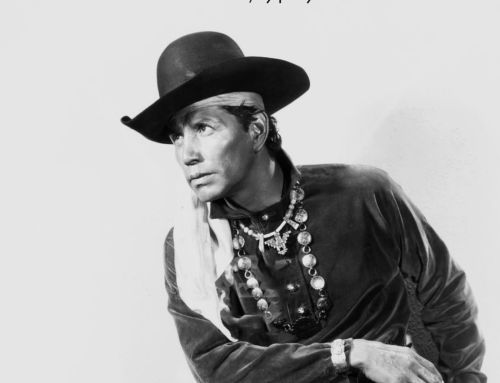
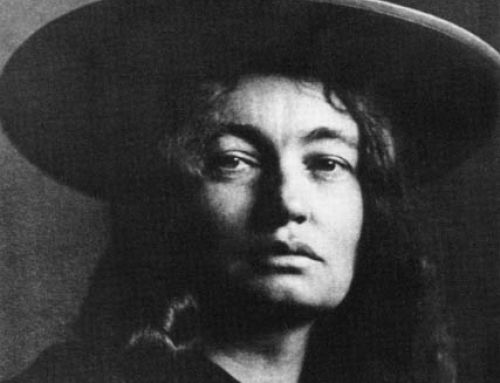
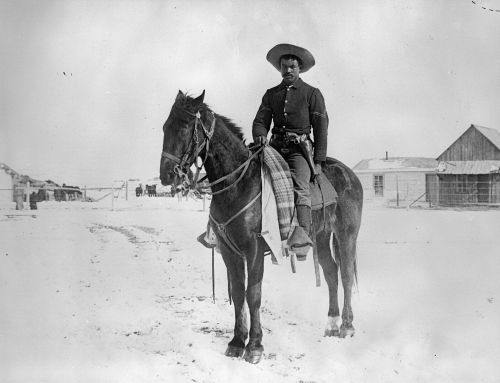
[…] The Buffalo Hunt […]